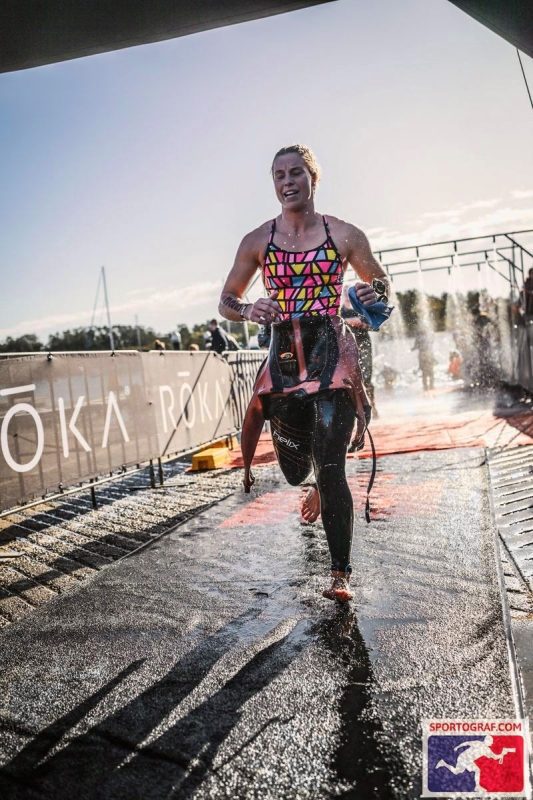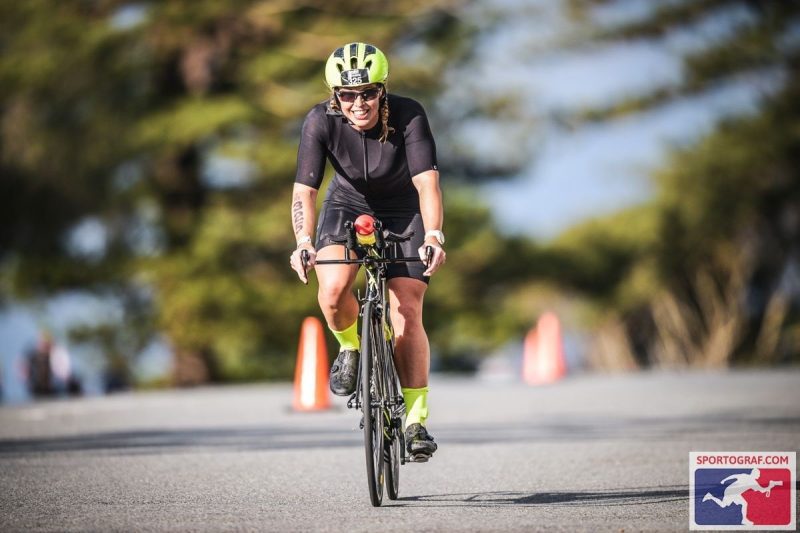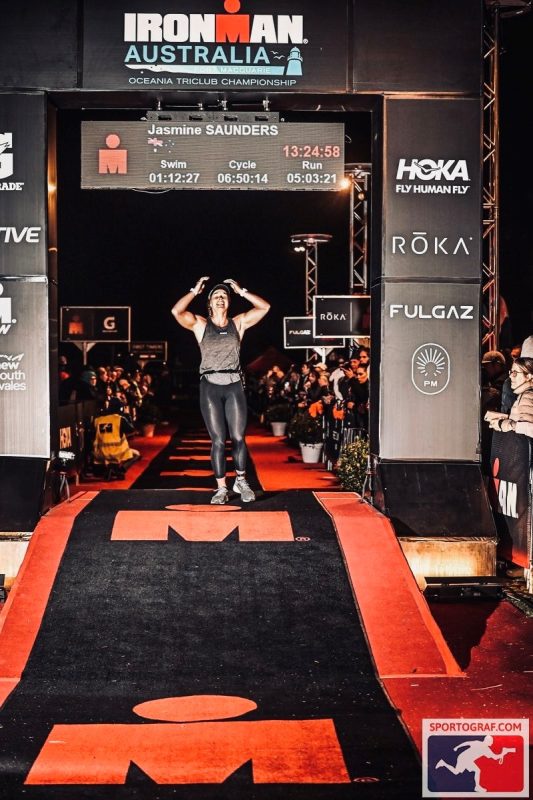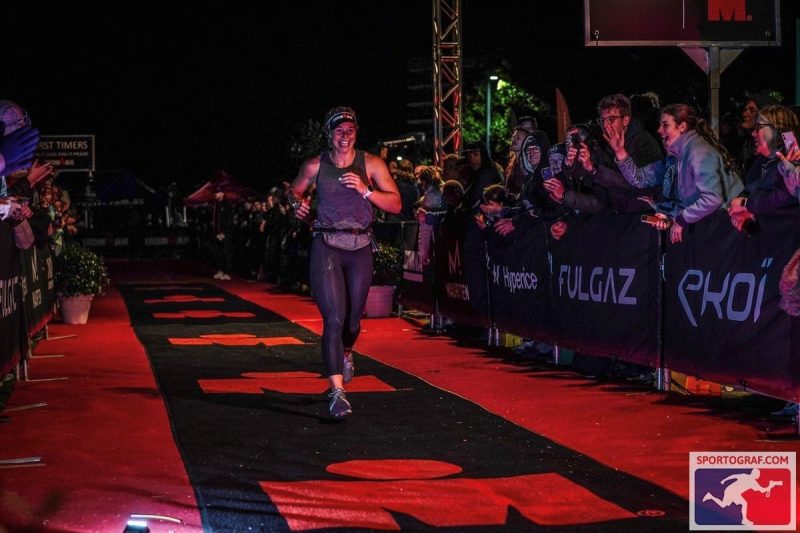Ironman Australia. A 3.8km swim, straight into a 180km cycle, and finishing off with a marathon run. So many people asked me why? Are you crazy? How long will that take? Questions that I was unable to answer.
In 2022, I completed a 70.3 Ironman (half the distance of a full Ironman). After finishing my race, I watched the full Ironman athletes as they continued racing into the afternoon, then the evening and then into the dark of night. After just finishing a race that was half the distance, I couldn’t fathom how anyone could complete the full. The distances were terrifying as a single event, let alone one after another, and somehow that is what made it appealing. So, I signed up. 
I knew how much training was ahead, so my next mission was to convince someone to do it with me. My colleague and good friend Tom Duck has also completed a half-distance Ironman before, and with only a little hassling, I convinced him to come along for the ride 😀.
The months of training then began. I was doing my best to juggle working full time, giving time and energy to my friends and family, training up to 18 hours per week, and still doing all the usual daily tasks. To do so, 4:30-5am wake ups became normal, training two times per day was more common than not, and I often felt tired. However, I had a big goal in place, and I was committed to making it happen. Thankfully, for some of the longer training sessions, I had great company. A special mention to Tom Duck, his mum Jane, and my husband Josh. These guys made the long bike rides much more entertaining and kept me accountable when I didn’t want to be.
Over the months, I built my tolerance to long swims, rides, and runs. Then, I started what is called ‘brick’ sessions. This is training two disciplines back-to-back. Generally, my monthly training schedule entailed three ‘building’ weeks (hard training), and then one ‘deload’ week (lighter training), implemented to help my body rebuild and recover. I followed this pattern until I reached my ‘peak’ week of training (biggest overall volume of training), before beginning a ‘taper’ 14 days out.
The aim of a taper is to keep moving, and maintain the strength and fitness you have built, whilst allowing your body to recover as much as possible. It involves a significant drop in volume of training, which I will admit did feel quite strange so close to the big day.
The taper days crept by quickly, and as the reality of Ironman got closer, my nerves got more intense.
We left early in the morning on a Friday to start driving to Port Macquarie and arrived in the afternoon. I was with a group of 9 people (friends and family) staying in an Airbnb that overlooked the ocean. That  evening we went for a walk to stretch our legs and had an early night. The next day is full of preparations. Early in the morning, we did a practice swim in our wetsuits, which gave us an opportunity to familiarise ourselves with the salty water. We then did athlete check-in and went through a briefing and tour of the transition area. Tom and I went home to pack everything needed for the next day. That night, I fuelled myself by eating a full pizza and went to bed early.
evening we went for a walk to stretch our legs and had an early night. The next day is full of preparations. Early in the morning, we did a practice swim in our wetsuits, which gave us an opportunity to familiarise ourselves with the salty water. We then did athlete check-in and went through a briefing and tour of the transition area. Tom and I went home to pack everything needed for the next day. That night, I fuelled myself by eating a full pizza and went to bed early.
Sunday started with an early alarm to start eating. I got up and forced myself to eat some vegemite toast and then attempted to go back to sleep – this didn’t happen. By 5:45am we were down at the swim start to cheer on my husband and sister who were both attempting the half Ironman for the first time. Tom and I both went and checked our bike tyre pressures, I ate an orange and energy gel, and gave my support crew a hug before heading off to the start line.
 As I stood among a crowd of athletes in wetsuits and caps, nervous but excited at the same time, I reflected upon my journey to getting to this point. As the buzzer sounded and I entered the water, I was crammed among hundreds of swimmers. I did my best to relax, focus on my breathing and keep my pace steady, as this certainly was not a sprint! Soon, the swimmers spread slightly, meaning I was getting kicked less and was able to sight the course better.
As I stood among a crowd of athletes in wetsuits and caps, nervous but excited at the same time, I reflected upon my journey to getting to this point. As the buzzer sounded and I entered the water, I was crammed among hundreds of swimmers. I did my best to relax, focus on my breathing and keep my pace steady, as this certainly was not a sprint! Soon, the swimmers spread slightly, meaning I was getting kicked less and was able to sight the course better.
I surprised myself with the swim, maintaining a faster pace than I had expected, and I felt really good. However, at the 2.5km mark, I began getting cramps in my legs. The intensity of the cramps increased, to the point where I had to stop until they faded enough for me to keep swimming. This pattern continued throughout the 1.3km remaining and worsened when I got out of the water. I got through transition and out onto the bike, and unfortunately, the cramps were relentless, soon my whole body was cramping. This made for a very mentally challenging ride. I moved positions as much as possible in the hope of reducing their severity, however muscles I didn’t even know could cramp were, including my face and neck when I tried to eat.
At about 160km, I felt defeated. I was frustrated that the cramps wouldn’t stop, and it was slowing me down. I will admit, I had a tear or two while down on the aerobars, before I pulled myself together and kept pushing on.
At 172km, riders face the dreaded Matthew Flinders Drive, an incline that many get off and walk up. Last year I remember feeling like I flew up the hill, even overtaking others on the way.
This year was a bit different…I stubbornly decided that I would not get off and walk. I got caught out with a severe cramp halfway up the hill, resulting in a spectator catching me as I could not get my feet around another rotation. After a few minutes on the ground, I pulled myself together and carried on. Finally, I made it to the end of the 180km. During my transition into the run, I was kindly offered a cramp-fix shot by an athlete who saw I was very drained by this point. Sadly, this did not seem to help much this late in the day, however, I set off on my 42.2km shuffle.
athlete who saw I was very drained by this point. Sadly, this did not seem to help much this late in the day, however, I set off on my 42.2km shuffle.
Thankfully, I was greeted by my family and friends at different points along the course which definitely helped boost my motivation. All their words of encouragement went a very long way.
The evening turned to night, and soon I was running on a dark course. The steps got shorter and tougher, not just for me but for everyone. I noticed more strangers making conversation as we shuffled one foot in front of the other, or even asking if we could jog together for a few kilometres just to keep motivated.
As I got closer to the end, I started getting butterflies in my stomach. When I could see the finish line, the overwhelming feeling came. The realisation hit me: I was about to become an Ironman. I had made it, all the training had paid off, I had achieved my goal. I wanted to soak this moment up. As I looked down the finishing chute, which was flashing with bright lights, pumping with loud music, and filled with spectators clapping, yelling, and cheering me on, I could see the end. As I ran down, physically I felt beyond exhausted, but emotionally I was on top of the world.
As I approached the finish line, I finally heard the words “Jasmine Saunders, you are an Ironman”.
The next hour was filled with hugs, photos and spent wrapped in a foil blanket. Tom and I stumbled as we walked to pick up our bikes and gear from the transition area, however still feeling on top of the world.
It’s funny, you spend so much time preparing for an Ironman, and discussing the event itself, no one really prepares you for afterwards. For close to 48 hours, all I could eat was burger rings (the ones you get from the chip aisle), and it was not until Tuesday night that I got a decent sleep again.
It took a few weeks to get back to feeling 100%, but I am now back in the gym regularly, enjoying taking my dogs for runs, having more time to spend with family and friends, oh and getting a few sleep-ins too.
Would I do it again? I won’t say no because anything is possible, but for now, I am content with ticking off a massive bucket list item and enjoying exercise in a more sustainable way.
Jas
